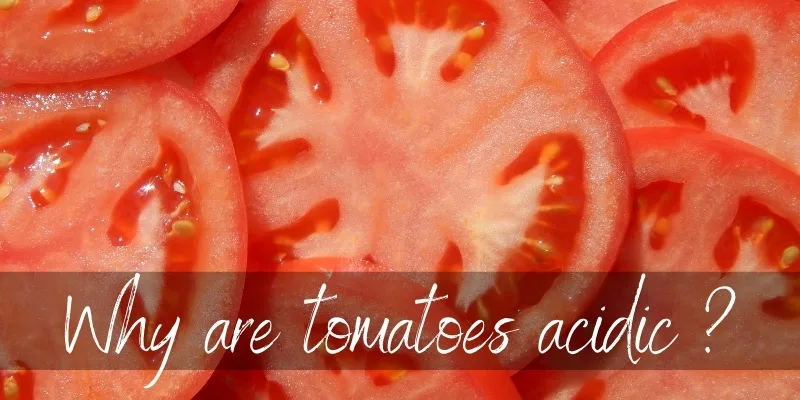If you’ve ever had a tomato you know it can get a little sharp in flavor. This can be good or bad, depending on your stomach problems and personal preferences. There are some vegetables and fruits that just seem to trigger heartburn, and tomatoes are one of the main perps.
But why are tomatoes acidic ? Are all tomatoes like this, or are some of them more mellow ? And what makes tomatoes sweet ? How can you tone down the acidity in tomatoes at home ? All this and more, coming right up.

Why are tomatoes acidic ?
Tomatoes are acidic in flavor because they contain three naturally occurring acids: malic acid, citric acid, and ascorbic acid (vitamin C). These three acids vary from tomato cultivar to cultivar, and in the end it’s the interplay between these acids and the natural sugars in tomatoes that gives them flavor.
When tomatoes ripen, their sugars develop more, and they manage to balance out the acids. This is why fully ripe tomatoes taste so good, and why even slightly unripe tomatoes can taste too sour and astringent.
As for why tomatoes develop acids in the first place, it’s partly for cellular respiration, and partly for ripening and texture. By the end of a tomato’s ripening process, the highest acid is malic, which is the one most responsible for texture and starch. Citric acid most mostly used for respiration, and goes down significantly as the tomato ripens.
This rings true for all fruits, as they tend to be more acidic than vegetables and of all of these, berries are the most acidic.
Different cultivars have different flavors
Each tomato cultivar has a little bit of difference in flavor, and there are a few things you should keep in mind. The most acidity is found in the tomato juice and the jelly around its seeds.
Read also: Should Tomatoes Be Refrigerated ?
Commonly, supermarkets sell unripe tomatoes, which are often very acidic and still have green seeds. This is done to make transport easier, and prolong the vegetable’s shelf life.
It seems the cultivars that have been bred to ripen to yellow are the ones with the least acidity, but this does not mean they are the sweetest. Conversely, tomato types with more flesh than juice – like Brandywine or beefsteak – have less acidity.
How can you tone down acidity in tomatoes ?
Alright, what can you do with the tomatoes you brought home if they’re acidic ? As in, too acidic to eat on their own ? Well there are a few things you can do, but we need to clear one thing up. If the tomato is still green on the inside – the seeds – and you’ve already cut it, there is no saving it.
Even if you add sugar, the acidity is still there and please don’t add baking soda. Now if your tomatoes are just fine, but you’d just like to tone them down a little, here’s what you can do.
Remove seeds and their jelly
If you’ve got a whole lot of tomatoes and don’t mind not using all of them, you can cut out and discard the seeds and jelly inside. This should only be done when the tomatoes have fairly good flesh, but the seeds still have a bit of green, but aren’t completely green.
Don’t get us wrong, you can still use the whole thing, seeds and all. But if you really want to remove the acidity, removing the seeds is the first step. They have the most astringency.
Add some sugar
Another option is to add a bit of sugar to your tomatoes, though it may or may not be a good idea in some recipes. In a salad it can be acceptable if it’s part of the dressing, like a honey-mustard dressing or something similar.
But if you’re making something that requires cooking the tomatoes, only add the sugar at the end, if simmering does not help. Let’s get to that.
Simmer for several hours
Simmering tomatoes breaks down the cell walls and develops any natural sugar that may already be present in them. And when you’re simmering tomatoes, they’re likely not alone. They’re likely accompanied by onions, carrots, celery, and the likes.

So this means you can easily get a nice helping of sweetness from the onions and carrots, without adding any additional sugar. For this to work you have to simmer on low for several hours, at least two. This way the flavors of your tomato sauce can really come together, and develop.
Why are tomatoes sweet ?
Tomatoes are sweet due to the natural sugars that develop as the tomatoes ripen. These sugars are called glucose and fructose, and they heavily influence how flavorful the tomatoes are.
Sweetness in tomatoes increases as the tomato ripens, and by exposure to adequate sunlight. This is why tomatoes grown in very warm, sunny regions develop much better, as opposed to colder but still sunny regions.
Read Also: What Does Dijon Mustard Taste Like?
Why are tomatoes sweeter when cooked ?
A tomato’s natural sugar is released and end up caramelizing as it slowly cooks for several hours – as is the case for an excellent pasta sauce. And as the sauce cooks down and moisture is released, the same amount of sugar is present, but in a higher dose in relation to how much liquids remains in the pot.
So in short, tomatoes are sweeter when cooked because there is less liquid, so the flavor simply becomes more concentrated.
You cannot take an unripe tomato and sweeten it with sugar, and expect it to taste just as good as a perfectly ripe tomato. A ripe tomato also has a lower acidity than an unripe one, and this is noticeable even if you cook them.
In short, tomatoes are first acidic, and then sweet. As the sweetness increases, the acidity lowers but never disappears completely.

